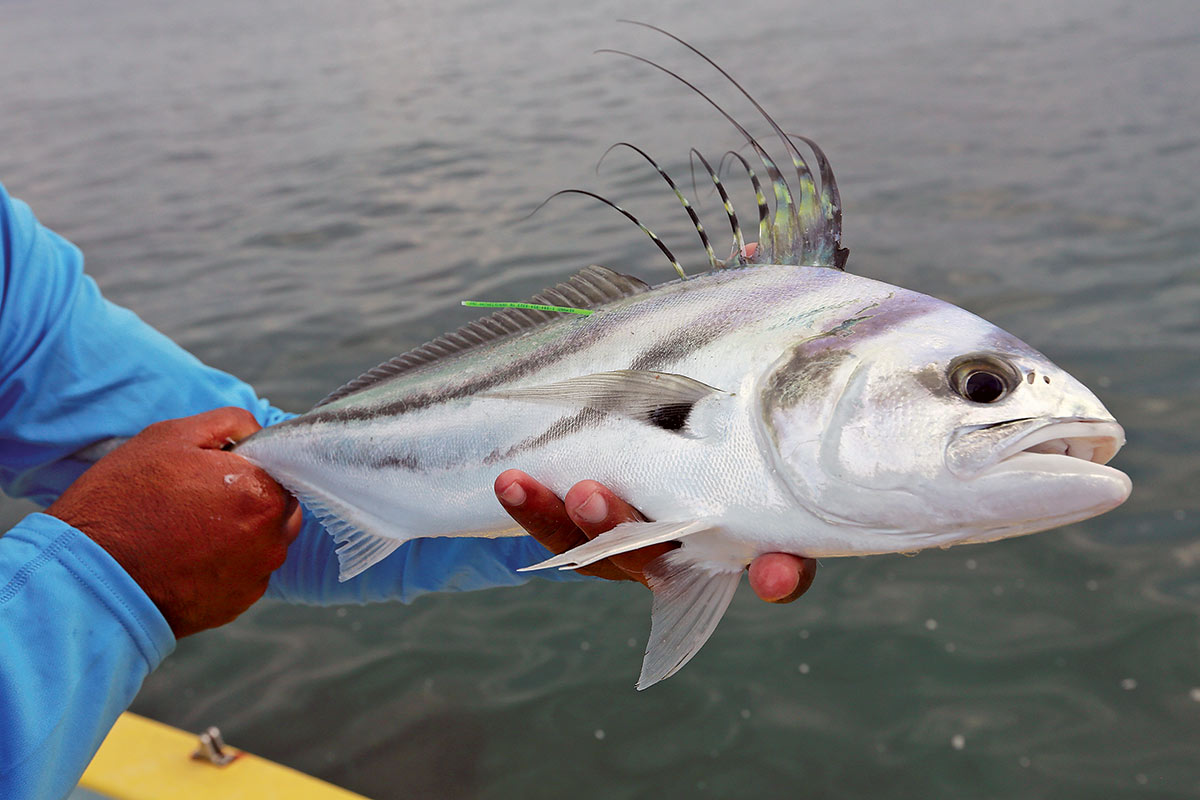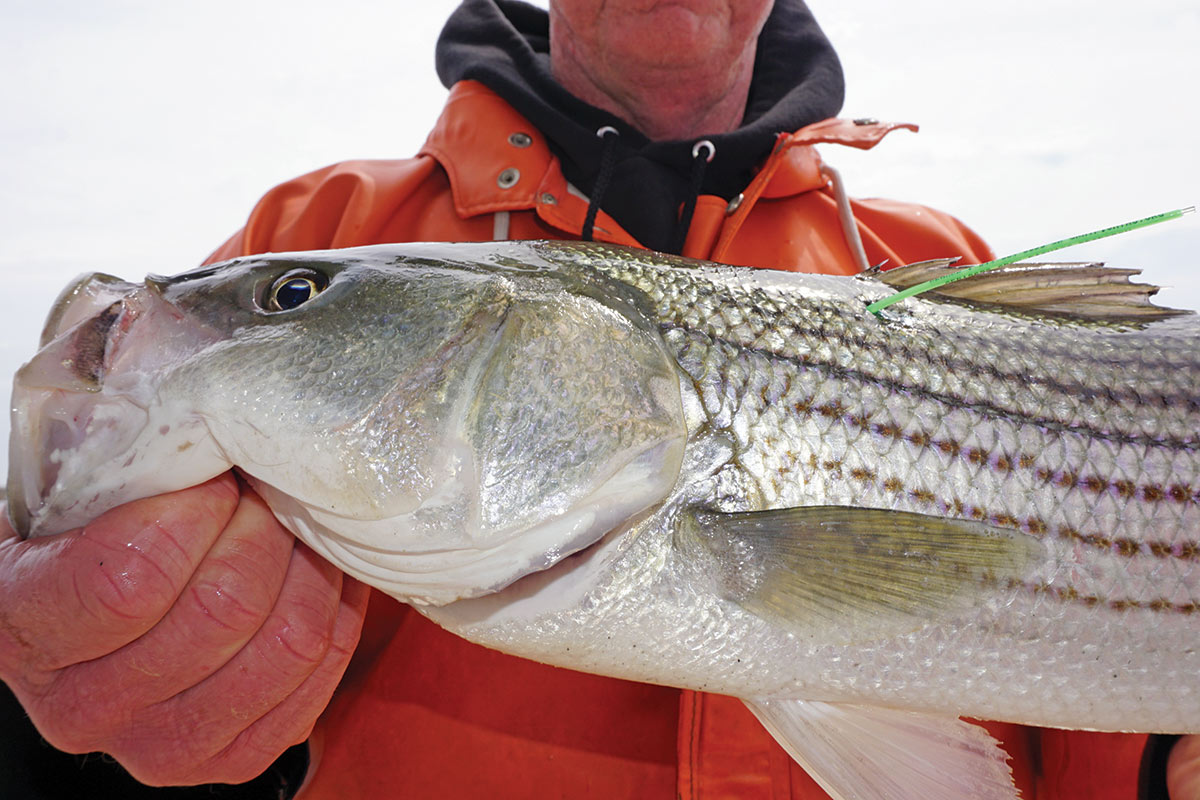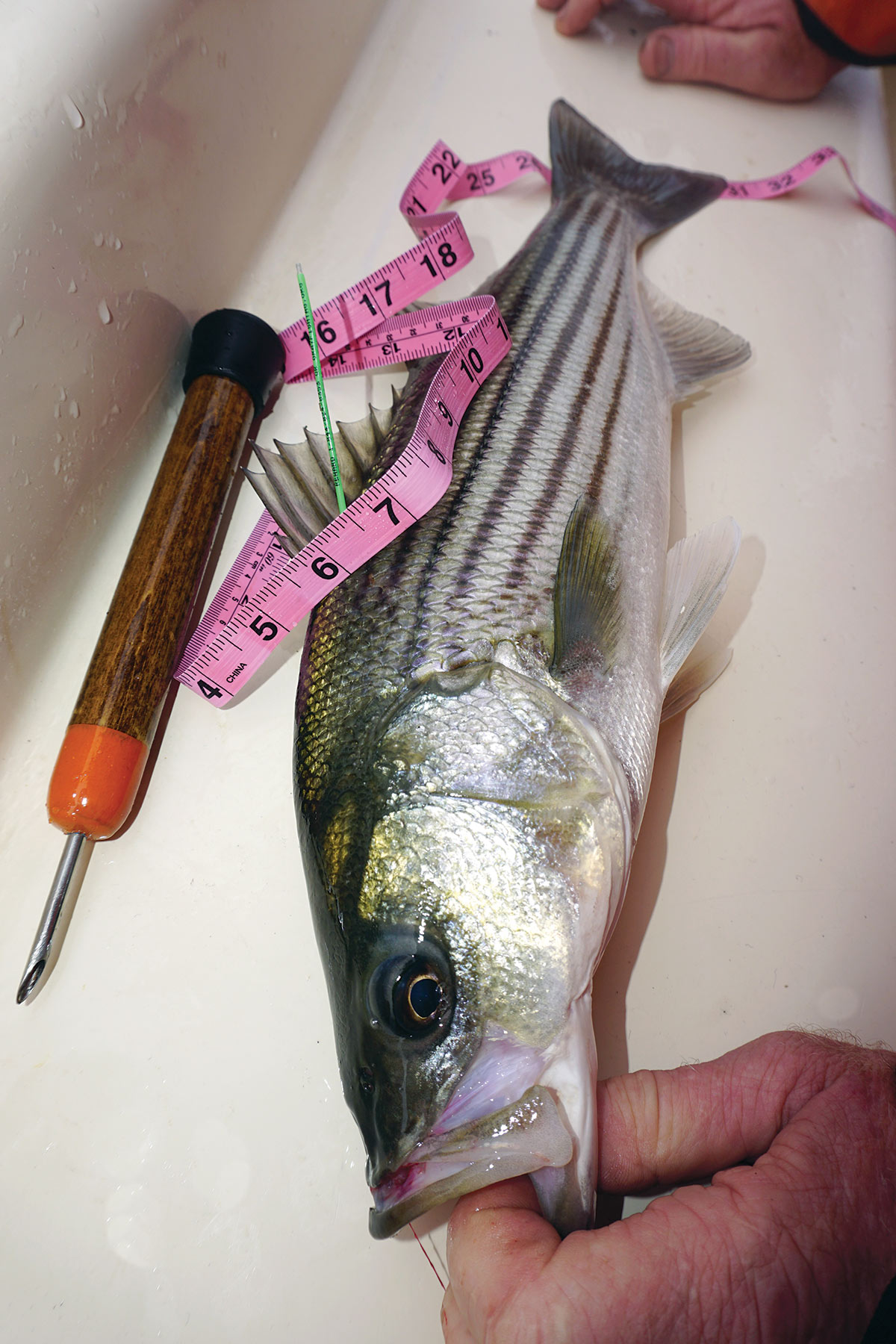
Gray FishTags to launch Northeast tagging effort at Manhattan Cup on June 8.
How many big striped bass are really out there beyond the three-mile line? Do they ever get caught inshore, along the beaches during the season, or do they just stay there in federal waters? And what about all those small, resident schoolies in the rivers and creeks; at what point do they actually leave the estuaries to join the coastal migration?
There’s so much we think we know about stripers, yet there are so many nagging questions still left answered. Why are so many of our most legendary striper grounds like The Rips at Cape May or Montauk Point so devoid of stripers, yet perennial hot spots like the Cape Cod Canal continue to see some of the very greatest action of the year towards the end of every summer? Is it the bait patterns? Beach replenishment post-Sandy?
As anglers, our immediate response to negative scientific response (Fluke populations aren’t growing; mako sharks are in trouble; the climate is changing.) is sometimes to scoff at the research and analysis. Of course, there’s often for good reason (think MRIP/MRFSS or the state of the black sea bass stock) for the stakeholder cynicism. Federal researchers with NOAA Fisheries are often highly protective of their data, and quick to take up the “best available science” defense while sometimes ignoring onwater observations by fishermen referring to that as “anecdotal” or unsubstantiated data.

Cooperative science – research where fishermen and other stakeholders work directly with federal and university scientists to gather data – is a powerful tool that’s being promoted more heavily in today’s world of NOAA Fisheries management. The agency itself has acknowledged how information collected through well-designed and scientifically valid cooperative research efforts between the private and public sector can be quite useful in improving the information base for single species, as well as multi species and ecosystem assessment models. The general view in the scientific community is that cooperative information gathering and sharing will help improve the overall evaluation of stock status and management of fishery resources.
This season, The Fisherman is working more closely with the folks from Gray FishTag Research, an international and fully interactive multi-species tagging program that collects real-time information from charter captains all over the world. While many of the ongoing data collection efforts for striped bass tagging in particular rely on volunteer anglers who purchase the tags and pay membership fees for access to information that’s not readily available to the general public, Gray FishTag Research relies on charter boat captains who make their living out of finding fish everyday they leave the dock.
Additionally, the Gray FishTag research data is meant to be shared in an open-source format available for private and public researchers to access; the ultimate goal for multi-species tagging is to collect as much information as possible and make it available for free to help bridge the gap between fishermen and the science community. And that’s where striped bass comes in!

Tags & Returns
In recent years, Gray FishTag professionals have focused a lot of attention on species in the Southeast and Central America; in the three years since the non-profit organization was launched in Los Sueños in Costa Rica, charter captains have done extensive work in tagging cobia, marlin, and even roosterfish, with invaluable returns compiled by the researchers back Gray. They’ve also launched a highly anticipated swordfish study that will carry through the next two seasons with support from major tackle manufacturers and outfitters to help deploy pop-up satellite archival tags (PSAT) to better understand swordie patterns along the Atlantic Coast.
Closer to home, Gray FishTag is looking to expand the tagging program with a closer look at one of our most important Northeast and Mid-Atlantic targets. At December 8, 2017 meeting of the Gray FishTag Fishing Research Advisory Board, board member Mike Caruso, the owner and publisher of The Fisherman, discussed a proposed striped bass tagging program; fellow board member Capt. Dave Marciano from “Wicked Tuna” concurred, noting the importance of learning more about this sought-after and popular regional species.

For the 2018 run of stripers, which is essentially well underway in our region, Gray FishTag is organizing and executing a striped bass study with the help of charter boat captains working with The Fisherman. While everyone involved in the striped bass fishery is interested in proper management and conservation ideals, Gray FishTag believes it’s the charter fishing operators who make their living catching striped bass who have the best access to the fishery with the potential to responsibly tag more fish while supplying more quality data than any other group or organization out there today. Gray FishTag in turn can help education and supply the professional charter boat industry with the tools necessary to contribute towards the data collection; by employing a full-time scientist who can train and captains and mates on how to engage their customers in tagging, naming and reporting released fish.
Of course, it also becomes another benchmark of success for a day on the fishing grounds; “We put one in the box, but we tagged another six fish over 40 that our charter was able to name in honor of family members,” the captain notes later in The Fisherman’s weekly fishing reports. Customers and taggers in turn interact online at www.grayfishtagresearch.org and by way of marina research centers in Costa Rica, Cabo San Lucas, Alaska and Ocean City, MD.
Tournament Tagging
On June 8, approximately 50 professional fishing guides will provide their boats and expertise to individual teams competing in the Manhattan Cup, one of the largest, one-day inshore tournaments in the Northeast with a strictly catch and release format. After a two-year hiatus, the tournament returns to the Hudson River again in 2018 running out of Liberty Landing Marina, thanks to the efforts of Capt. Frank Crescitelli and the Recreational Fishing Alliance (RFA). The contest will include live-release, fly fishing, wounded veterans and celebrity categories once again, but a new wrinkle will provide a new tagging incentive through Gray FishTag.
“Tournaments are a huge target for us in the years ahead,” said Gray Fish-Tag research center coordinator Bill Dobbelaer, adding “The northeast is such a priceless market, especially in terms of fishing tournaments, and we’re willing to supply the tagging materials for the first year for sure. By working with The Fisherman and RFA at the Manhattan Cup to incorporate a dedicated tagging effort in 2018, Dobbelaer hopes to expand on the tagging universe in the years ahead. “In the long term we need more great partners like Seguar and Costa Del Mar to help us along,” he said of the types of corporate support that can help bring more tagging concepts into local fisheries like striped bass, bluefish and fluke.
As a kickoff to Gray’s tagging efforts throughout the region, Dobbelaer plans to bring a trophy sized Gray Taxidermy striper mount, a 50-incher, to be awarded to the team who tags the most striped bass in the shortest period of time on June 8. A unique addition to this particular handcrafted American striper mount is an actual Gray FishTag slotted just beside the dorsal fin. By providing enough tags and tagging kits for all the participating teams to incorporate into their daily tournament efforts, the hope is to kick off a wide scale tagging effort for striped bass this spring. Ultimately, Dobbelaer and his team believe that more tournament organizers – whether striped bass, mako shark or even fluke – will want to adopt similar contest parameters in the future by which released fish can also add up towards tournament prizes.
“If we can get guys to tag one or two fish on each boat in future tournaments, think about the data we’ll be getting down the road,” Dobbelaer.

For the Manhattan Cup, which had been one of the premiere catch and release striper tournaments when it first kicked off in 1999 (running through until 2014), incorporating a prize component for tagging is only natural as the event is reborn in 2018. “The timing is so key right now,” said Caruso who is looking forward to the Manhattan Cup and the kickoff the striper tagging efforts. “We’re seeing so many anomalies, with micro bass on the beach and big spawners seeming to stay so far offshore, so it would be nice to uncover even just a small part of what’s going on.”
Crescitelli said the Manhattan Cup has always tried to lead by example in an effort to release as many of the genetically superior, breeding class stripers as possible. “Add in tagging and now you can track the patterns of these very important fish and engage people in the process, to me it seems like a no brainer,” he said.
Not just striped bass either, but Gray FishTag Research says anglers can tag just about any fish they catch in an effort to gain valuable return data for future use, which means sharks, summer flounder and other important local fish species as well. Said Dobbelaer, “We want data on bluefish, we don’t know what we want the data for just yet but we’re going to need this type of information on bluefish somewhere down the road too.”
Oyster Creek Bass
Well before those big, migratory striped bass make their way into the region in late spring, winter holdovers keep much of the striped bass fanatic’s attention focused along rivers and sod banks. One particular “hot spot” in Central New Jersey is the warmwater outflow from the Oyster Creek Generating Station. Earlier this year, the Exelon Corporation, which runs the nuclear powered plan announced plans to cease electric generation operations this fall. While the banks of the Oyster Creek have become a mecca of sorts for early season stripers when New Jersey’s back bay season opens on March 1, it remains to be seen of course what the future will bring for this fishery without artificial warmth. For many local captains like Steve Purul of Reel Fantasea Sportfishing who splash in March to take advantage of this outstanding light tackle action, these are just a few more of the big questions with striped bass migration.
What happens when the boiling-water reactor ceases to provide prime winter habitat for wintering striped bass? Where will those short stripers go when there’s no constant 60- to 70-degree water to keep them happy and feeding throughout the cold, Northeast winner? To perhaps get some of those answers down the road, I joined Capt. Steve on a little tagging mission in late March along the creek with a few good friends. The first laughing gulls of the season greeted us at the dock in Waretown, NJ on the Barnegat Bay, and by the time we entered the mouth of Oyster Creek minutes later to the sound of spring peepers in the trees and ospreys falling from the sky upon schools of bunker, all signs were looking good.
Drifting the creek with Tsunami split tails and jigs tipped with bloodworms, the current batch of residents were pretty hospitable. As first-timers, the tagging was fairly easy. Measure each fish, and using the green numbered card associated with each individually numbered tag, information is collected on size, fish condition, location, estimated weight, lure used and length of time the fish was fought. Each angler’s name and address is included on the card, along with a personalized name for each tagged specimen, which I entered into the database at GrayFishTag.com later. I named Tony Stanziano’s first fish after my grandfather; angler Loren Adrian honored his grandfather with a tag as well. Capt. Steve named his fish after his boat, where Jay Simmons opted for “Philly Special” and “Wentz” which I imagined might not go over well should those fish someday make their way into New England waters.
After tagging half-dozen stripers between 17 and 25 inches, I questioned myself why I’d never done any tagging before. Thinking of all those unknowns about the coastal migration, I wondered if we wouldn’t know more today if we’d all gotten involved in tagging efforts with groups like the American Littoral Society in the past. But the fact is, you can teach old dogs new tricks, and through his experiences traveling throughout Central America, the North Pacific and along the Caribbean to provide his tagging expertise to new anglers, Dobbelaer says there will always be new opportunities, especially with how Gray FishTag Research hopes to make their return data open to everyone for review.
“In every one of these places, we’ve discovered it’s never too late to start tagging, and it never has to end either,” Dobbelaer said. “This isn’t some gimmick, we’re going to need tagging forever.”
| TAGGING & TOURNEY INFO |
|---|
|
For charter boat captains and tournament organizers interested in incorporating Gray FishTag concepts into their upcoming trips and events, email [email protected]. Learn more about Gray FishTag Research online at www.grayfishtagresearch.org. The Manhattan Cup will run out of Liberty Landing Marina and Liberty House Restaurant in Jersey City, NJ across from the NYC Financial District on June 8. To reserve a boat, donate your personal or charter boat for the event or to fish the private angler category, visit www.manhattancup.com or call Capt. Frank Crescitelli at Fin Chasers Charters, 917-468-4817; you can also contact RFA directly at 888-JOIN-RFA. |




